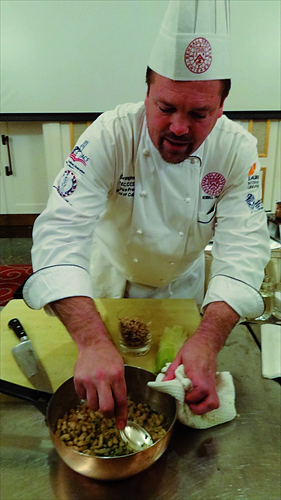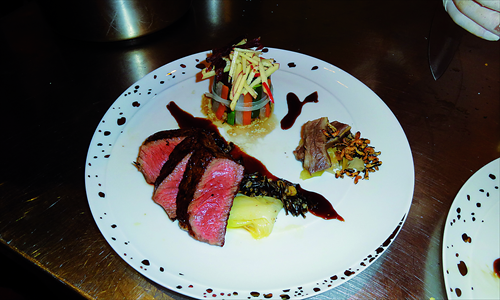Melting pot
American master chef spreads the word about culinary arts and sustainable cooking
As a master chef, Christopher Koetke travels around the world to spread his enthusiasm for fine cuisine. Hailing from Indiana, Koetke began cooking when he started working in a restaurant in his hometown when he was 13, where a French chef taught him how to cook. He has worked in some of the best kitchens in the world, including French restaurants Pavilion Elysees, Pierre Gagnaire, Taillevent and Pierre Orsi. He has also been certified as an executive chef by the American Culinary Federation.

American chef Christopher Koetke gives a master class in Shanghai. Photos: Yang Lan/GT
As Vice President of the Center of Excellence in Culinary Arts at Chicago's Kendall College, Koetke recently toured China to promote fine dining and the culinary arts program. In a master class held at the Peninsula Shanghai, he demonstrated what you could expect to learn in a culinary school, and made a meal in two hours.
He began with basic skills such as holding a knife and cutting vegetables, and then went on to selecting and cooking meat, and the characteristics one needs to become a great chef. He also cooked several signature dishes from Chicago.

One was a green tomato pickle, which makes use of tomatoes that have failed to ripen due to cold weather - a practice that dates back over a century.
"Instead of throwing the green tomatoes into the garbage, Chicago people made them into pickles," Koetke said.
To make the pickle, he diced the green tomatoes, sliced the cabbage into chunks, and chopped up red peppers, green peppers and celery. Then he added sugar, salt, black pepper, vinegar and spices to the vegetables. He brought the mixture to a boil and cooked it for about 45 minutes. While the dish was cooking, he talked about maple syrup, a sustainable product.

"Maple syrup is one of the greatest sustainable products. When the snow is deep, people drill three holes in each of the sugar maple trees. They put tubes in the trees and wait for the spring to come," Koetke said. "When the temperature rises, the sap from the bottom of the tree begins to go up. Some of the sap goes through the tubes and ends up in barrels. We reduce the sap by 50 times, and 50 liters of sap only makes 1 liter of maple syrup."
He used the maple syrup in a sauce for the meal he was making, which ended up combining seasoned steak, corn beef, braised beef, wild rice, beans and apple salad.
The wild rice was nutty and crunchy. The steak was smoky, and slightly spicy. The sauce was sweet and sour. The vegetables brought a beautiful color to the whole dish.
Delicious and healthy, the meal was made to illustrate a new trend in cooking that is seeing chefs take the food of their own countries and getting creative with it. Such dishes are not traditional food, but the ingredients are all local.
For Koetke, the most important thing in a meal is the taste. "It is like dating a person. When you see people, and they are beautiful, you will think that this will be a great date. And then they may have good perfumes, so they smell good. But if you discover that they have terrible personalities, you raised your expectations, and then you dropped. So if the food does not taste good, it is always a disappointment," Koetke told the Global Times.
During his time in China, Koetke has enjoyed going to small Chinese restaurants to taste the local dishes. He believes that such small restaurants are where one can taste the soul of a country.
After two to three days in Shanghai, he could not stop talking about the delicious Shanghai dishes that he tried, including baby eels, braised duck with brown sauce, eggplants and purple yams.
"The fun thing about China is that the dishes are so widely diverse, that you can eat forever in China and never eat everything," Koetke said. "For people from outside to try the best food of a country, you need to step outside of your comfort zone. Food is more than food. Food is culture, and food is who you are. When you are experiencing the food of someone's country, you are getting the whole picture. I consider that very precious."
While loving food from all different cultures, Koetke is very proud of American food culture. "People outside the US do not always see the food culture of the US," he said. "To me, the American food culture is a combination of the native people with the immigrant groups that come. There is a lot of original food tradition," Koetke added.